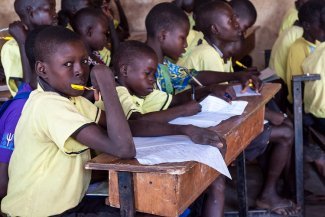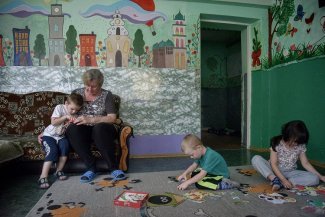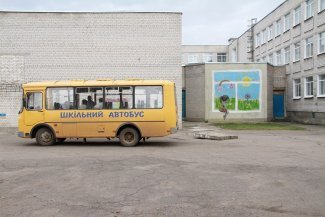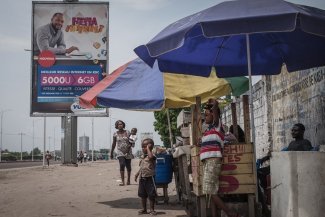Making schools a target of war is a violation not only of international humanitarian law, but of a child’s right to education. Globally, over 33 million children living in areas affected by armed conflict are unable to go to school.
Ukraine is no exception. The war, which is one year old today, 24 February, is having a devastating impact on the lives and the futures of 5.7 million children of school age, who have been robbed of stability, safety in the classroom, friends and dreams of a future.
Since the start of the armed conflict, more than 3,000 educational institutions have been damaged by shelling. Of these, 420 have been completely destroyed, according to figures from the Ukrainian Ministry of Education and Science.

Millions of children’s basic rights to protection and education are violated around the world. Portrait of 14-year-old Darija Nikolajenko in front of what is left of her school, which was shelled by Russian forces on 3 March 2022. 27 September 2022, Chernihiv, Ukraine.
Attacks on schools in the context of armed conflict have become a growing and alarming trend worldwide. During 2020 and 2021, over 5,000 attacks on education or incidents involving the military use of schools and universities were reported, in which at least 9,000 students and educators were harmed or killed. On average, six attacks on education or incidents of military use took place every day.
From Afghanistan to Yemen, Syria, South Sudan, Mali, Democratic Republic of Congo, Ukraine and Colombia, warring parties are flouting “one of the most basic rules of war: the protection of children,” says UNICEF.
“Children are direct targets in conflicts around the world. We cannot accept this as the new normal,” warns UNICEF’s executive director, Catherine Russell, recalling that “a child’s right to education cannot be safeguarded in conflict situations without protecting education itself”.

A leaflet on the use of gas masks among the wreckage of school no. 15. The school was attacked on 7 March. 10 April 2022, Kramatorsk, Ukraine.
“Disrupting the learning of children living in war zones has a lifelong impact, limiting their future opportunities. It’s going to impact their ability to learn and develop, to be able to find a place in society,” explains Delphine Dorsi, director of the Right to Education Initiative.
“The challenges facing education are many, but they are not impossible,” stresses Dorsi. To stop wars from destroying the future of entire generations around the world, governments need to ratify, implement and support the Safe Schools Declaration, which Ukraine endorsed in 2019, to protect all students and education workers from the worst effects of armed conflict.
In spite of everything, the bombs have not succeeded in destroying the education system in Ukraine. The work of the Ministry of Education – resuming classes – and the financial and institutional support of organisations such as the United Nations have made it possible to keep the system afloat. One example is the UN Special Fund and ‘Education Cannot Wait’, which have provided around US$5 million in emergency aid for children affected by the war, both for their education and mental health. In addition, since the invasion began, some 760,000 children have received formal or non-formal education through United Nations Children’s Fund (UNICEF) support programmes and over 1.7 million children and caregivers have benefited from the health and psychosocial support interventions supported by the agency.
The efforts to keep up with classes in a country at war have been significant. A month after the outbreak of the war, Ukrainian schools, colleges and universities resumed classes online and since September face-to-face schooling has returned for primary school pupils, who take turn to attend classes, given the large number of schools that have been damaged or destroyed and are no longer operational.

Veronika, age 11, follows an online class at home in Kharkiv: “I feel better when I see my classmates online; it helps take my mind off the bad news and the war.” 14 April 2022, Kharkiv, Ukraine.
For teachers, the return to school, whether face-to-face or online, is essential, even if it only serves to give a semblance of normality to the millions of children affected by the conflict. But teaching in the midst of war is not easy.
“It’s not the same as when we resumed classes online because of Covid. I am aware that we are under a lot of pressure, on a daily basis – the heads of the schools, the teachers and the students. It takes a huge psychological effort to concentrate, to give or receive lessons with the constant wailing of sirens, with parents telling us every day that they are leaving for other cities or other countries and, ultimately, not having contact with our pupils for a while,” explains Tetiana Mashkun, a teacher at secondary school no. 21 in Chernihiv, which was destroyed in shelling on 3 March.

Darija Nikolajenko inside what remains of her school. 27 September 2022, Chernihiv, Ukraine.
Chernihiv is just 50 kilometres from the Belarus border, and although it was not taken by Russian troops, it came under heavy siege during the first month of the war.
The canteen and kitchen of secondary school no. 21 was occupied by the Civil Defence Forces, where they cooked for Ukrainian troops, but many families from the neighbourhood would also go to the school’s air-raid shelter for protection when the sirens sounded. Forty-eight people were killed in the heavy shelling, which also destroyed school no. 18.
It is not easy to overcome such a trauma. Some of 14-year-old Darija Nikolajenko’s school friends died on the way to the air-raid shelter. Darija has stopped in front of the rubble and ruins to which her school has been reduced. “War is the worst thing that can happen to the human race. Especially in the 21st century. I can’t imagine how we reached this point. My school was my second home. It is hard to imagine my future. All I can think about is a future without war,” reflects Darija, who has had to return to classes online as there are not enough schools now and some of them do not meet the safety standards.

A map of Ukraine in a deserted classroom in Irpin. The school was attacked in March 2022. Before the war, 1,858 children studied at this infant school in Irpin. Today, the building is a jumble of metal and rubble after receiving 30 missile strikes, seven of them direct. 30 September 2022, Irpin, Ukraine.
Less than sixty per cent of the schools deemed safe were able to reopen in September. In the eastern regions, which are on the front line, the local authorities decided not to open the schools and to keep all education online, while farther away from the front lines, educational institutions were partially opened, provided they had an air-raid shelter.

Sviatoslav, aged 10, attends school no. 25, a renovated building where UNICEF has built an air-raid shelter. He moved here after his school was completely destroyed. “Now I go to this one, and although it’s fine here, I want to go back to my old school,” he says. 29 September 2022, Zhytomyr, Ukraine.
Ten-year-old Sviatoslav, compared to hundreds of thousands of other children his age who will not return to school this academic year, can consider himself fortunate to be back at school. Sviatoslav started the academic year in a new school. His previous school, Lyceum No. 25 in Zhytomyr, was completely destroyed by shelling on 4 March.
For the boy, going back to school is quite an experience, as his education has been disrupted ever since he started primary school, practically, first by the initial two years of the pandemic and then the war.

School No. 15 was attacked on 7 March at 3.30 in the morning. An estimated average of 22 schools a day were attacked in Ukraine at the beginning of the war. 10 April 2022, Kramatorsk, Ukraine.
“Despite the risk of sending their children to school, many parents feel that it is safer than studying at home, because when the air raid sirens go off, the teachers take the pupils down to the shelter,” explains Ivan Denisyuk, head of School No. 25.

Children in a playground. Background: destroyed buildings in Borodyanka, a town that suffered heavy shelling by Russian forces at the beginning of the war. Over 90 per cent of the city centre was destroyed. 29 September 2022, Borodyanka, Ukraine.
Keeping education going is a way of resisting the war. “It is very important that children go back to school. They are the future, they will help us rebuild and strengthen Ukraine,” exclaims Denisyuk. As Nelson Mandela would say, “education is the most powerful weapon which you can use to change the world”.















